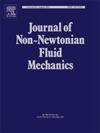粘弹性对比驱动的液滴悬浮在受限液体结构中的电流体动力学行为
IF 2.7
2区 工程技术
Q2 MECHANICS
引用次数: 0
摘要
我们提出了一个近似的解析模型(不妥协的物理)的电流体动力学(EHD)的封闭泄漏介电,非牛顿粘弹性液滴悬浮在周围的介质相似的特性。该分析通过一个小变形公式来考虑斯托克斯流型。通过将柯西动量方程与上对流麦克斯韦(UCM)模型耦合来实现粘弹性特性。由于本研究局限于低电场强度,故控制Weissenberg数(Wi)≤1。我们考虑液滴和周围环境的各种组合,即NN-N、N-NN和NN-NN情况。与N-N情况进行了彻底的比较。这里,“N”代表牛顿,“NN”代表非牛顿。本文提出的解决方案已通过文献中的实验观察得到验证,并在低电场强度条件下取得了成功。我们表明,对于无约束域,N-N情况下的变形最大,N-NN情况下的变形最小,从而建立粘弹性对比的作用。对于约束域,我们还观察到N-NN和NN-NN在较高约束(α)和较低电流变参数(δ)下的形状反转。对于NN-N,超过临界α时,变形比N-N时大。我们还报道了不同情况和不同约束条件下液滴内部和周围介质中的流线模式。研究结果揭示了受限粘弹性情况下的形状反转现象,并为流体约束下的EHD提供了见解,为微流体装置的设计和功能提供了潜在的途径。本文章由计算机程序翻译,如有差异,请以英文原文为准。
Viscoelasticity-contrast driven electrohydrodynamic behaviour of a droplet-suspended-in-a-confined-liquid configuration
We present an approximate analytical model (without compromise on the physics) of the electrohydrodynamics (EHD) of a confined leaky dielectric, non-Newtonian viscoelastic droplet suspended in a surrounding medium of similar characteristics. The analysis considers the Stokes flow regime through a small deformation formulation. The viscoelastic behaviour is realized by coupling the Cauchy momentum equation with the upper convected Maxwell (UCM) model. Since the study is limited to low electric field intensities, the governing Weissenberg number (Wi) 1. We consider various combinations of the droplet and the surrounding, viz. NN-N, N-NN, and NN-NN cases. A thorough comparison with the N-N case is conducted. Here, ‘N’ represents Newtonian and ‘NN’ represents non-Newtonian. The solution put forward is validated with experimental observations in literature and works successfully in the regime of low electric field strength. We show that, for an unconfined domain, the deformation is maximum for the N-N case and least for the N-NN case, thus establishing the role of viscoelasticity-contrast. For the confined domain, we have also observed shape reversal in N-NN and NN-NN cases at higher confinement () and lower electro-rheological parameter (). For NN-N, the deformation is greater compared to the N-N case beyond a critical . We also report the streamline patterns within the droplet and in the surrounding medium for various cases and for different confinement. The findings reveal shape reversal phenomena in confined viscoelastic cases, and provide insights into the EHD with fluidic confinement, offering potential avenues for the design and functionality of microfluidic devices.
求助全文
通过发布文献求助,成功后即可免费获取论文全文。
去求助
来源期刊
CiteScore
5.00
自引率
19.40%
发文量
109
审稿时长
61 days
期刊介绍:
The Journal of Non-Newtonian Fluid Mechanics publishes research on flowing soft matter systems. Submissions in all areas of flowing complex fluids are welcomed, including polymer melts and solutions, suspensions, colloids, surfactant solutions, biological fluids, gels, liquid crystals and granular materials. Flow problems relevant to microfluidics, lab-on-a-chip, nanofluidics, biological flows, geophysical flows, industrial processes and other applications are of interest.
Subjects considered suitable for the journal include the following (not necessarily in order of importance):
Theoretical, computational and experimental studies of naturally or technologically relevant flow problems where the non-Newtonian nature of the fluid is important in determining the character of the flow. We seek in particular studies that lend mechanistic insight into flow behavior in complex fluids or highlight flow phenomena unique to complex fluids. Examples include
Instabilities, unsteady and turbulent or chaotic flow characteristics in non-Newtonian fluids,
Multiphase flows involving complex fluids,
Problems involving transport phenomena such as heat and mass transfer and mixing, to the extent that the non-Newtonian flow behavior is central to the transport phenomena,
Novel flow situations that suggest the need for further theoretical study,
Practical situations of flow that are in need of systematic theoretical and experimental research. Such issues and developments commonly arise, for example, in the polymer processing, petroleum, pharmaceutical, biomedical and consumer product industries.

 求助内容:
求助内容: 应助结果提醒方式:
应助结果提醒方式:


